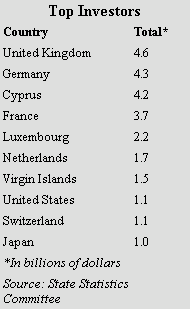Russia attracted a record $29.7 billion of foreign inflows last year, led by foreign loans, as the longest economic expansion since the fall of the Soviet Union boosted demand for credit.
Foreign inflows soared 50 percent from 2002. Foreign loans led the gains with $22.2 billion of the total $29.7 billion, the State Statistics Committee said in a statement. Foreign direct investment rose 69 percent to $6.8 billion and portfolio investment fell 15 percent to $401 million.
"Russians are starting to front Russia, and that's great," Westin said. The biggest investors in Russia are based in Germany, Cyprus, Britain and the United States, contributing more than half of the $57 billion of foreign inflows into Russia from abroad since 1991. The figure includes direct, portfolio and other inflows. Industry, trade and food sectors lured the bulk of last year's inflows, or $22.8 billion. Meanwhile, outflows from Russia, classified by the State Statistics Committee as Russian investment abroad, rose 17 percent last year to $23.3 billion. That money flowed to the British Virgin Islands, Belarus, Iran, Cyprus, the Netherlands, Liberia, Moldova, Switzerland, Armenia and Lithuania, the committee said. "These flows show the transfer of money from Russia to offshores and later re-investment of that money either in Russia or in other countries,'' said Vladimir Tikhomirov, an economist at NIKoil in Moscow. "This is about the optimization of taxes by Russian companies.'' Portfolio investment totaled just $401 million last year, according to the committee, while total trading on the Russian Trading System's main stock market reached $6.1 billion last year. In the second half of 2003, the country attracted $17 billion of foreign investment, or 57 percent of the total yearly figure, according to calculations based on Thursday's release and the data for the first half. That indicates that foreign investment, as represented by the State Statistics Committee, was not affected by concerns about the Oct. 25 arrest of former Yukos CEO Mikhail Khodorkovsky on charges of fraud and tax evasion. Last July, Khodorkovsky said "politically motivated'' investigations into Yukos and its shareholders would prompt capital to leave the country and delay decisions about investing in Russia. (The Moscow Times 23.ii.04)
Subscribe to the TT Business Intelligence Report |
||||||||||
